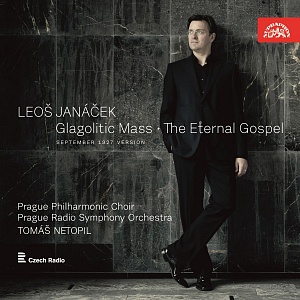
TOMÁŠ NETOPIL´S NEW ALBUM
"JANÁČEK’S WORK IS SO CONCISE AND POWERFUL, SO DRAMATIC AND DIRECT"


In the wake of the highly acclaimed recording of Janáček’s symphonic works (Sinfonietta, Taras Bulba, etc., SU 4131; Orchestral Choice, Gramophone, August 2013), Tomáš Netopil and the Prague Radio Symphony Orchestra have focused on the composer’s vocal- instrumental pieces. The Glagolitic Mass is a generally known work, yet not in the composer’s original „September 1927“ version, as it was performed at the premiere in Brno, which has been recorded for the very first time for this CD (SU 4150–2). It is fascinating to observe how many distinct traits of Janáček’s expressive musical language have vanished from the work as a result of its later modifications. The Eternal Gospel, on the other hand, is a piece virtually unknown worldwide (the only previous Supraphon recording was made almost fifty years ago). Discover more about Janáček's work and Tomáš Netopil's attitude to his phenomenon in interview with musicologist Jiří Zahrádka.
Despite your relatively young age you are a widely acclaimed interpreter of Janáček’s work. Do you remember when you heard Janáček for the first time and what impression his music made on you?
It was the Glagolitic Mass that first captivated me, early on in my violin studies, and that then accompanied me through my subsequent discovery of Janáček’s symphonic and chamber work. His operas were a chapter in themselves: I was completely overwhelmed by them, and studying them in more detail made me think about why it is that Janáček’s work is so concise and powerful, so dramatic and direct…
There’s no doubt that Janáček’s music is highly authentic and dissimilar to anything in Czech or world music. I often ask myself what exactly makes it so powerful? But finding an answer to that question is rather difficult. Put simply, and quite “unmusicologically”, it’s music that is completely truthful…
Yes, Janáček does write truthful music, but aren’t we doing other composers a bit of a disservice? In my opinion every composer tries to give a truthful account of his internal world and it's tensions, and this finds its outlet through his composition. Janáček, of course, found a way to make direct emotional contact through a musical language that is concise and down-to-earth, full of expression in a typically slavonic way, and yet spiritually delicate, even intimate. He found his own unmistakeable musical voice — one that is marked out by a close bond between word and music; I’d say it’s really a transformation of word into music. This might sound like a cliché, but think about the broad range of expressive techniques that Janáček created in this way. I think that this also explains the great fondness in which the composer is held and the fact that people around the world understand his work even though they don’t understand the Czech language.
And now to Janáček’s most famous cantata: the Glagolitic Mass. This is the first recording of the so-called “September 1927” version of the work. Janáček wrote his mass in the very fruitful year of 1926, when he also wrote the Sinfonietta amongst other pieces. He composed his monumental cantata in one month. The September 1927 version was probably the one heard at the work’s premiere in Brno on 5 December 1927 and it is significantly different from the final revised version…**
If we compare the original version of the work with the later, more generally known one, we come across some quite fundamental differences in the instrumentation, the construction and in the motifs. In the first part of the original version we immediately feel that we are dealing with Janáček at his purest. After the introductory bars of pulsating brass an atmosphere of rich rhythmic chaos builds, out of which the brass’s clear introductory theme emerges once again like a lighthouse of certainty. Unfortunately, in the revised versions this key contrast is missing and our sense of the first part of the Mass is that it takes place on only one level. The middle of the Credo section also sounds extremely dramatic as Janáček uses three groups of tympani, the organ and a soloist from the choir to create an electrifying climax. However, we are very often deprived of this moment too. In the revised versions even the choir, despite its strong solo role, loses the very impressive and exposed climax at the conclusion of the Sanctus. These revisions partly arose for practical reasons (e.g. three groups of tympani are not usually available) but also because of the high interpretative demands on the orchestra and choir. There are greater or lesser degrees of interference at various places in the composition which, in the final analysis, makes a major difference to the overall sound of the work.